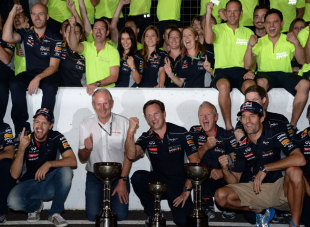- Japanese Grand Prix
Webber cost himself chance of win - Horner

Christian Horner has explained the reasons behind Red Bull switching Mark Webber to a three-stop strategy in the Japanese Grand Prix, saying his inability to pass Romain Grosjean cost him a chance of victory.
Webber was the lead Red Bull on track during the first half of the race but admitted his surprise that the team chose to switch to a three-stop strategy while team-mate Sebastian Vettel remained on a two-stop to win the race. With Webber questioning Red Bull's strategy, Horner said the decision had been taken to give both cars the best possible chance of passing early race leader Grosjean.
"The key aspect was obviously the first stint," Horner said. "We went in to the race hoping and thinking it would be marginal for a two-stop but we believed that probably in clear air that we could do that. I think the first stint dictated everything for us when Mark put Grosjean under quite a lot of pressure and went through the tyre phases pretty quickly to the point that he'd run out of tyres by the lap he pitted on - I think it was nine or something like that - pretty early in the race, which was too short for us in our own minds to make a two-stop really work because you'd effectively run out of tyres in that last stint.
"So as the race opened up for Mark and [Daniel] Ricciardo held the rest of the field back, some clear track space opened up. While Sebastian was able to do the opposite, Grosjean pitted to cover Mark and Sebastian was able in clear air to run at a very quick pace having conserved his tyres. That happened again during the second stint and as the gap opened up for Mark effectively it was a free stop; we felt that was the best way to attack and pass Grosjean with Mark and do the opposite with Sebastian. Of course that then puts Lotus in a very difficult decision because which car do they cover?
"Effectively you've got a bit of a chess game going on strategically, but with the benefit of clear air Mark was able to run a very quick pace. Sebastian, having conserved his tyres, went about five laps longer than we expected him to, so when Sebastian pitted and came out behind Grosjean he used those tyres incredibly well to pass him very quickly - he closed on him and passed him immediately with a very brave move down the pit straight - and then knew that he was effectively racing Mark who was going to be on a different strategy and a softer, quicker tyre at the end of the grand prix.
"When Mark pitted I think with 10 or 11 laps to go and went on to the softer tyre, obviously he closed in on Grosjean pretty quickly but then came across a bit of traffic and unfortunately didn't go past Grosjean too quickly and that killed off any chance he had of winning the race. But it was great to see him make the move on Grosjean and obviously fantastic for the team to get a one-two finish."

